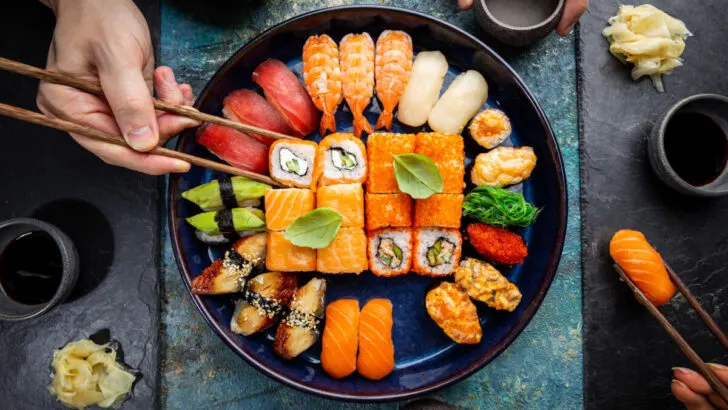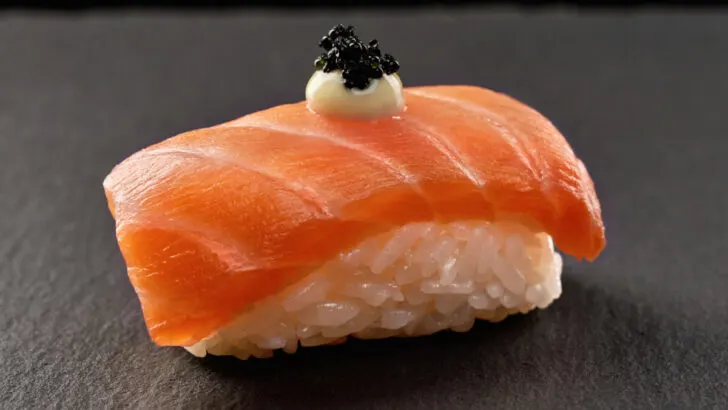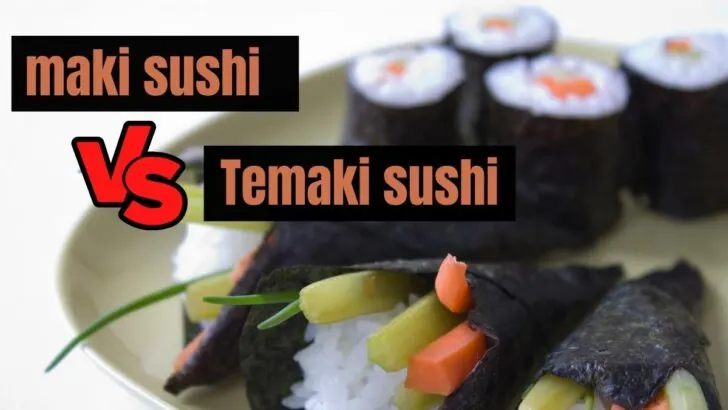Have you recently developed a love affair with sushi? If the answer is yes, then you might be straining your memory to keep the track of all the various sushi varieties.
However, we must bet that you have encountered temaki and maki rolls. If yes, then you’re probably thinking about how and why they differ.
The biggest difference between maki and temaki is their shape. Maki is often rolled and cut into six to eight little pieces and eaten with chopsticks, whereas temaki rolls are consumed with your hands and are more akin to an ice cream cone.
Let’s dive deep into their key differences and see what else I’ll be covering in this article!
- What Is Maki?
- What Is Temaki?
- Differences Between Maki And Temaki
- Similarities Between Maki And Temaki
- How To Tell Maki And Temaki Rolls Apart
- What Are Some Other Types Of Sushi?
What Is Maki?
Rolling sushi is referred to as maki, norimaki, or makizushi. Maki rolls can be made by hand or with a makisu (a bamboo mat), and they can be small or big.
They always include toasted nori seaweed-wrapped sushi rice and toppings.
Other than this, Makizushi is frequently served with soy sauce and gari (pickled ginger) to freshen the palate.
It can be an appetizer, a main course, or a component of a bento box. Also, they are typically divided into bite-sized pieces.
What Is Temaki?
Temaki is the hand roll kind of sushi.
They often consist of vinegared rice, sashimi (raw fish), vegetables, or other contents encased in cone-shaped nori (seaweed).
In Japan, cooked seafood is frequently used for temaki, including shrimp tempura (deep-fried shrimp prepared in the Japanese style), smoked salmon, and even Tamago, a sweetened egg omelet found across many sushi restaurants.
Differences Between Maki And Temaki
Both hand and sushi rolls share the same basic components, as well as the traditional dipping sauces of wasabi and soy sauce.
While maki and temaki both share the wrapped form with sashimi, three key distinctions set them apart from nigiri sushi.
Shape
The shape is the primary distinction between temaki and maki.
Using a bamboo sushi mat, the contents are rolled into a tube-shaped maki, and a thick coating of nori surrounds the whole thing. With the help of a tiny sheet of nori, temaki is manually rolled into a cone form.
Modifications
Temaki is any cone-shaped sushi, however, there are other varieties of sushi that fall under the category of maki rolls.
Futomaki, which includes popular American sushi menu items like the Philadelphia roll and California roll, refers to maki rolls containing numerous fillings.
It’s not uncommon for these rolls to feature meat in addition to the fish or other major elements.
A basic tuna or cucumber roll is an example of a hosomaki, which is a type of maki roll with just one filling.
In uramaki, the cooked rice is placed outside the sheet of nori seaweed and sprinkled with sesame seeds before rolling them up.
Eating
Maki is often rolled and cut using a sharp knife into six to eight little pieces and eaten with chopsticks, whereas temaki rolls are consumed with your hands and are more akin to an ice cream cone.
Similarities Between Maki And Temaki
Now you know the differences between maki and temaki, it’s time to know what’s common between them.
The Stuffings
These two sushi varieties’ materials share the most similarities. When ordering various kinds of sushi, you are not required to stick with a specific style or filling.
Most will feature nori, rice, and fish like tuna or salmon, but that’s not all there is to it! However, if you’re considering tasting sushi, this trio is definitely the greatest choice to make.
There are numerous solutions available to vegans as well. If you like, you can omit the fish and stick to the nori, rice, and substitute fillings like cucumber or avocado.
There are many possibilities for someone who wishes to taste a variety of flavors.
Most menus provide a selection of sushi, including the well-known California roll.
How To Tell Maki And Temaki Rolls Apart
Here are some specific details to tell apart maki and temaki:
- Maki roll is referred to as Maki zushi, while Temaki sushi is the name of the hand roll
- Unlike hand rolls, which are shaped like cones and eaten with hands, maki rolls are cylindrical and are split into pieces
- Maki roll is a popular style of rolled sushi that is available in stores and eaten at sushi restaurants, but temaki is typically produced at home and is great for gatherings
- Maki rolls are consumed with chopsticks whereas, temaki is consumed with hands
What Are Some Other Types Of Sushi?
There’s no use in discussing the distinctions between temaki and maki without touching on the wide variety of sushi available.

There are various distinct types of sushi available and this is not an exhaustive list. If you remember these names by heart, it will be helpful as many menus won’t have photographs of sushi next to it.
1. Hosomaki and Futoki
Hosomaki can be compared to a single-filling, thinner variant of maki. Hosomaki is cucumber or salmon maki since it only has one filling and rice.
On the other hand, Futomaki is the complete opposite. Hosomaki-style fillings can be added to this, which is similar to a larger form of hosomaki. Cucumber, salmon, rice, and roe are common fillings for futomaki.
2. Uramaki
Consider uramaki as inside-out maki. Sushi rice is rolled around at least two different ingredients and then encased in nori.
Sesame seeds, roe, or something else crunchy is then sprinkled over this rice. Whatever the topping, it serves as a barrier to keep the rice from sticking to surfaces or clumping together.
3. Nigiri

This is just fish—typically raw—cut into incredibly thin strips and spread like a blanket over rice. You typically also get some wasabi with this. Nigiri made of tofu or vegetables is also an option.
Nigiri can be larger, even though it’s normally bite-sized.
In contrast to maki, you will always receive just one topping.
4. Sashimi
Sashimi is simply slices of meat—typically raw—served with pickled ginger, soy sauce, and wasabi but no rice.
The flavors are subtle, therefore not everyone will enjoy the quality and sophistication. In general, stay away from this entirely if you’re new to sushi.
5. Gunkanmaki
This is very much like Maki, but with a great deal more flair. Roe is often used as a topping, and ingredients are thoughtfully arranged to produce lovely designs.
After rolling the sushi rice into a little ball, the distance between the rice and the outside will be around half an inch.
Final Words on Temaki vs. Maki
Sushi is a traditional Japanese cuisine that consists of vinegared rice that has typically been mixed with sugar, salt, and a range of other ingredients, such as vegetables and seafood that is frequently raw.
Maki and temaki are one of the most types of sushi available at restaurants. However, the main difference between them is you can eat maki with chopsticks while temaki with your hands.


